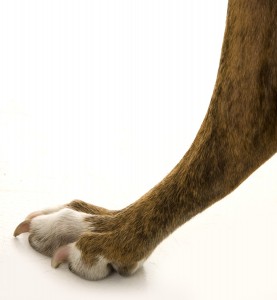
Click to learn how to do the Monthly Challenge.
Picture what you want your pet to do when it’s nail trimming time, or time to wipe your dog’s paws. What is different about that and what you have now? Is there any room for improvement?
My vision for nail trimming is that the dog is in a comfortable position, actively giving you her paw to file or trim.
What does your situation look like now?
- Does your dog run away and struggle, bite, or shiver when you try to trim his nails?
- If your bird holds still while you do his claws, do you still need to catch him and hold him in position?
- Does he willingly come over to you but you still need to grab his paw to do the trimming?
- Do you use nail clippers but you’d like to use a nail file or a Dremel?
- Would you like to train your dog to file his own nails on a big scratching board or wipe his own muddy paws?
- Does your cat use your couch as a scratching post?
Whatever can be changed, come up with a goal for that and apply most of your pet’s calories and other reinforcers toward achieving it. Follow the guidelines of the Monthly Challenge to keep yourself motivated.
This could be a training goal, but you may be looking for more of a management solution, like building or purchasing a new cat scratching post.
Tip: When properly trimmed, your dog’s nails should not make a lot of sound on the floor. Your dog should be able to stand with the nails off the ground. Now some dogs have very long quicks (the pink part), like the ones shown here, and you need to just trim as well as you can, hopefully chasing the quick shorter and shorter.
Tip: A Dremel or other sanding tool can be really great for doing your dog’s nails. But it takes practice! Here’s a tip from Jon Porter: get yourself a box of pencils and practice sharpening them without touching the lead inside (that simulates the ‘quick,’ the pink part you don’t want to hit. Also remember not to sand in the same place for too long, because it gets hot. Practice at first with a stationary pencil and then see what happens if someone is moving it, as a dog might do. Jon recommends attaching it to a stick with a rubber band, but you can get creative on that.
Useful videos from the Member Library:
- Empowerment:How to Build Cooperation and Trust
- 10 Ways that Your Pet Says “I need space”
- 10 Ways that Your Pet Says “I’m OK”
- Watch This Before Petting Another Animal!
- Problem Solving 101
- The More Please Signal Will Change Your Pet’s Life